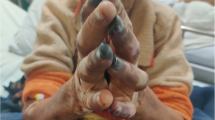Abstract
Raynaud's phenomenon is a common vascular side effect of chemotherapy drug regimens. Chemotherapy-induced Raynaud's phenomenon leading to acral gangrene has rarely been reported. In this report, one patient who developed gangrene after bleomycin and vincristine/vinblastine chemotherapy for AIDS-related Kaposi's sarcoma and another HIV-infected patient who exhibited symptoms of severe Raynaud's phenomenon related to the same regimen are presented. Because the combination of bleomycin and vinca alkaloids is commonly used for the treatment of AIDS-related Kaposi's sarcoma, clinicians should be aware of the risk of provoking acral necrosis in patients who develop Raynaud's phenomenon under chemotherapy. The literature is reviewed, and clinical symptoms, pathophysiology, and treatment options are discussed.
Similar content being viewed by others
References
Vogelzang NJ, Bosl GJ, Johnson K, Kennedy BJ: Raynaud's phenomenon: a common toxicity after combination chemotherapy for testicular cancer. Annals of Internal Medicine 1981, 95: 288–292.
Fertakos RJ, Mintzer DM: Digital gangrene following chemotherapy for AIDS-related Kaposi's sarcoma. American Journal of Medicine 1992, 93: 581–582.
Elomaa I, Pajunen M, Virkkunen P: Raynaud's phenomenon progressing to gangrene after vincristine and bleomycin therapy. Acta Medica Scandinavica 1984, 216: 323–326.
Cohen IS, Mosher MB, O'Keefe EJ, Klaus SN, DeConti RC: Cutaneous toxicity of bleomycin therapy. Archives of Dermatology 1973, 107: 553–555.
Vayssairat M, Gaitz JP, Bamberger N: Digital gangrene, HIV infection, and bleomycin treatment. Journal of Rheumatology 1993, 20: 921.
Lafeuillade A, Alessi MC, Poizot-Martin I, Dhiver C, Quilichini R, Aubert L, Gastaut JA, Juahan-Vague I: Protein S deficiency and HIV infection. New England Journal of Medicine 1991, 324: 1220.
Werquin S, Kacet S, Caron J, Lacroix D, Libersa C, Coget JM, Lekieffre J: Phenomene de Raynaud et necrose digitale apres traitement d'un seminome ovarien par bleomycine, vinblastine et 5-fluoro-uracile (Raynaud's phenomenon and finger necrosis after treatment of ovarian seminoma with bleomycin, vinblastine, and 5-fluorouracil). Annales de Cardiologie et de Angeiologie 1987, 36: 409–412.
Toumbis-loannou E, Cohen PR: Chemotherapy-induced Raynaud's phenomenon. Cleveland Clinic Journal of Medicine 1994, 61: 195–199.
Hansen SW, Olsen N: Raynaud's phenomenon in patients treated with cisplatinum, vinblastine, and bleomycin for germ cell cancer: measurement of vasoconstrictor response to cold. Journal of Clinical Oncology 1989, 7: 940–942.
Finch WR, Rodnan GP, Buckingham RB, Prince RK, Winkelstein A: Bleomycin-induced scleroderma. Journal of Rheumatology 1980, 7: 651–659.
Bellmunt J, Navarro M, Morales S: Capillary microscopy is a potentially useful method for detecting bleomycin vascular toxicity. Cancer 1990, 65: 303–309.
Caumes E, Katlama C, Guermonprez G, Bournerias I, Danis M, Gentilini M: Cutaneous side-effects of bleomycin in AIDS patients with Kaposi's sarcoma. Lancet 1990, 336: 1593.
Author information
Authors and Affiliations
Rights and permissions
About this article
Cite this article
Reiser, M., Bruns, C., Hartmann, P. et al. Raynaud's phenomenon and acral necrosis after chemotherapy for AIDS-related Kaposi's sarcoma. Eur. J. Clin. Microbiol. Infect. Dis. 17, 58–60 (1998). https://doi.org/10.1007/BF01584368
Issue Date:
DOI: https://doi.org/10.1007/BF01584368




